Tests help uncover potential issues in code, and the various types of tests offer different levels of coverage.
This document guides developers (component authors, driver authors, and API/ABI maintainers) on the essential tests for validating Fuchsia software.
The table below provides an overview of the types of tests categorized by what needs that type of test.
| Source Code | Components | Drivers | Protocols | |
|---|---|---|---|---|
| Unit | All | - | - | - |
| Integration | - | All | Some | - |
| Compatibility (CTF) | - | Some | Some | All (SDK) |
| Spec Conformance | - | Some | All | Some |
| Platform Expectation | - | Some | Some | Some |
| System Interaction (Product) | - | Some | Some | Some |
The following sections categorize types of tests in terms of the following criteria:
- What needs it (what source code, packages, or components need this kind of test)
- What does it test
- What are its key benefits
- Where to view coverage (how can you determine this test is working and measure its impact)
- How to implement (what actions do you need to take as a developer to get this coverage)
- Who writes this kind of test (who is responsible to provide this coverage)
- Where are the sources stored (where do you place the test)
- When does Fuchsia run this type of test (when in the release pipeline is this kind of test run)
Unit Tests
- What needs it: All source code
- What does it test for: Code contracts for individual units of software
- What are its key benefits: Permits more effective refactoring, optimization, and development.
- Where to view coverage: https://analysis.chromium.org/coverage/p/fuchsia
- How to implement: Use a test framework for your language of choice
- Who writes this kind of test: All component/driver owners
- Where are the sources stored: Adjacent to the code being tested
- When does Fuchsia run this type of test: Commit-Queue and Continuous Integration
All code should be covered by the smallest possible test that is able to validate functionality. Many functions and classes in the languages we use can have their contracts tested directly by small, focused unit tests.
Unit Testing is a well understood area, and for the most part Fuchsia developers may use any test framework for their language of choice, with a few notable differences:
- Tests that run on a device (Device Tests) are distributed as Fuchsia packages and run in an environment under the control of Test Manager. By default these tests are completely hermetic and isolated from the rest of the system, files output by tests cannot be seen by any other test.
- Device tests may expose custom
artifacts
which are streamed to the host device by
ffx test. - Device tests compiled to produce coverage information have that
data streamed off of the device automatically. Tools like
ffx coveragehelp to automate the processing of the data. Coverage information is surfaced in Gerrit and the Fuchsia Coverage dashboard for in-tree tests, while OOT test executors will need their own scripts to process the coverage output of tests.
Learn how to write driver unit tests in the Driver unit testing quick start.
The diagram below shows unit tests running in a Fuchsia system.
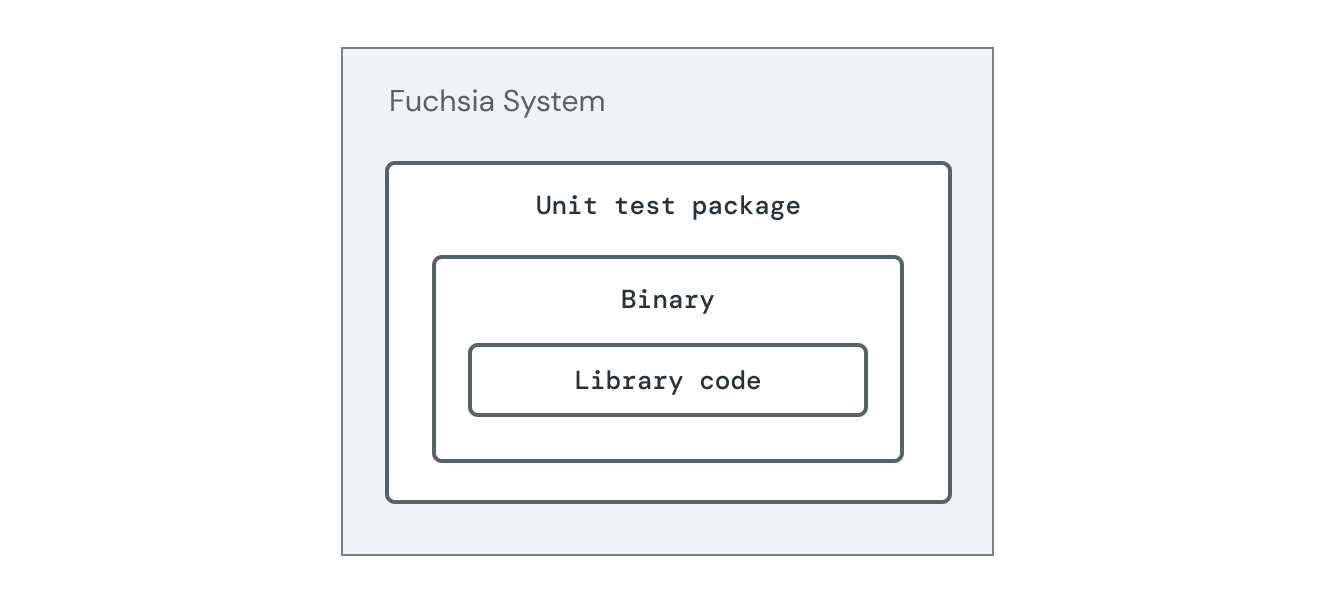
Integration Tests
Integration tests check that the interface and behavior of one component works alongside another component that calls it. Validate that different components work together as a system and interact as expected.
The following scenarios are validated for the component under test:
- It can actually start up and respond to requests
- It responds as expected to requests
- It interacts as expected with its own dependencies
- If the driver is made up of multiple components, check the components are behaving correctly inside the driver
The recommendation is to to run integration tests hermetically (in isolation) using Test Realm Factory, but they can be run in non-hermetically if needed.
Hermetic Integration Tests
- What needs it: All components and many drivers
- What does it test for: Runtime behavior and contracts
- What are its key benefits: Ensures that a component or driver can start up, initialize itself, and interact with dependencies
- Where to view coverage: https://analysis.chromium.org/coverage/p/fuchsia. Note that OOT use cases require build option changes to output coverage information and process it.
- How to implement: Test Realm Factory
- Who writes this kind of test: All component authors, many driver developers
- Where are the sources stored: Adjacent to the code being tested
- When does Fuchsia run this type of test: Commit-Queue and Continuous Integration
While unit tests are small and focused on specific pieces of business logic, Integration Tests are focused on testing the interactions between software modules as a group.
Integration testing is another well understood area, but Fuchsia provides features for testing that are radically different from what exists on other operating systems. In particular, Fuchsia's Component Framework enforces explicit usage and routing of "capabilities" that builds on top of Zircon's capability-based security principles. The end result is that Fuchsia tests can be provably hermetic and recursively symmetric. The implications of these properties have been referred to as "Fuchsia's testing superpower." Tests may be perfectly isolated from one another, and components may be nested arbitrarily. This means that one or more entire Fuchsia subsystems may be run in isolated test contexts (for example, DriverTestRealm and Test UI Stack).
The diagram below shows hermetic integration tests using the Test Realm pattern.
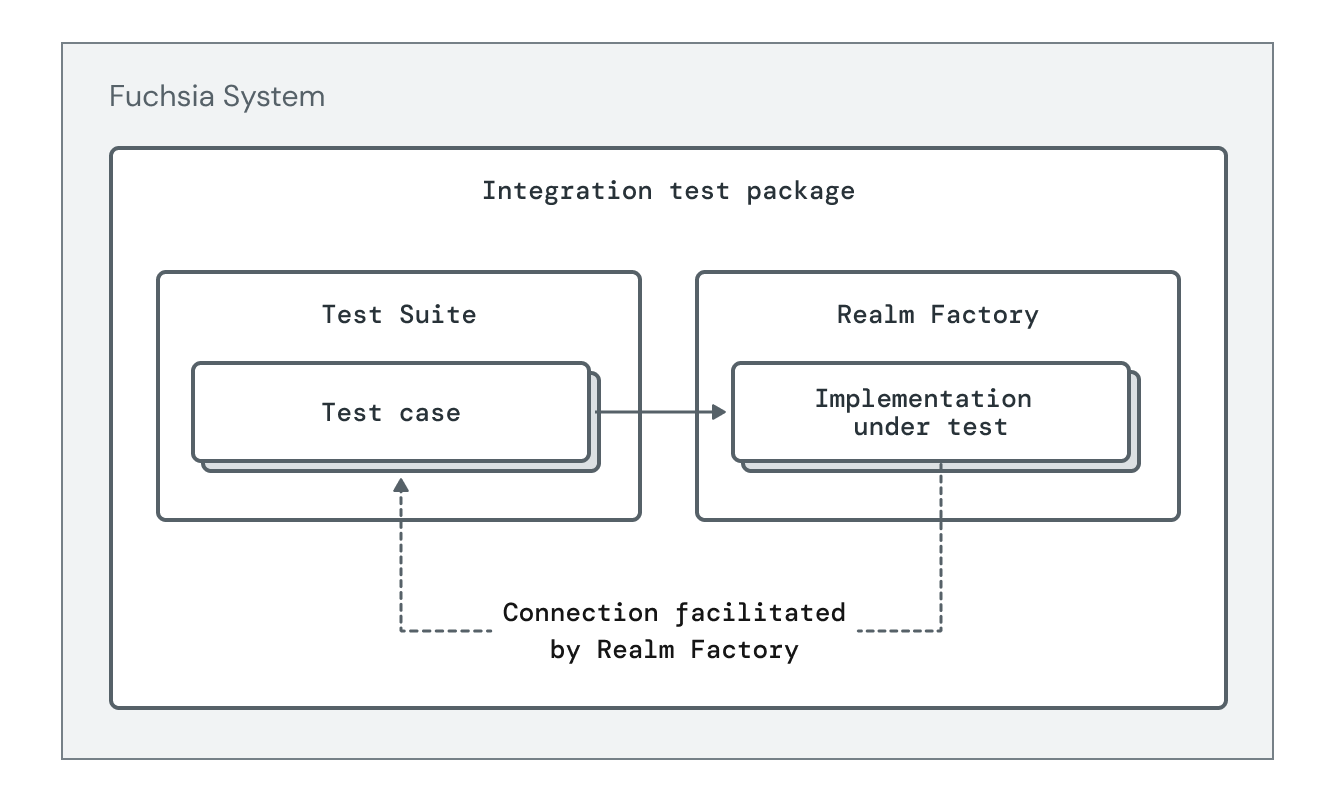
All tests on Fuchsia are hermetic by default, which means they automatically benefit from provable hermeticity and the ability to arbitrarily nest dependencies.
Hermetic Integration Tests simply build on top of this foundation to run a component or driver in an isolated test environment and interact with it using FIDL protocols. These tests cover the following scenarios for a component/driver:
- It can actually start up and respond to requests
- It responds as expected to requests
- It interacts as expected with its own dependencies
The recommended pattern for writing hermetic integration tests is Test Realm Factory (TRF), which prepares the test for reuse in different types of tests below. TRF tests have three parts:
- A Test Realm, an isolated instance of the component under test and all of its dependencies.
- A Test Suite, which interacts with a Test Realm and makes assertions about its state.
- A RealmFactory protocol, unique to each test suite, which is used to construct Test Realms.
Each test case in the Test Suite calls methods on the RealmFactory to create a Test Realm, interacts with that realm over the capabilities it exposes, and asserts on the responses it receives. The TRF docs provide instructions for using the testgen tool to automatically create skeletons of the above to be filled out with details.
Hermetic Integration Tests using TRF forms the foundation for many of the below types of tests.
All components and many drivers require an integration test, and those tests should use TRF.
Non-hermetic Integration Tests
- What needs it: Some components and drivers. Specifically those that have dependencies that are difficult to mock or isolate (e.g. Vulkan).
- What does it test for: System behavior and contracts
- What are its key benefits: Ensures that a component or driver can start up, initialize itself, and interact with dependencies, even when some of those dependencies are system-wide and non-hermetic.
- Where to view coverage: https://analysis.chromium.org/coverage/p/fuchsia. Note that OOT use cases require build option changes to output coverage information and process it.
- How to implement: Test Realm Factory
- Who writes this kind of test: Some component and driver authors
- Where are the sources stored: Adjacent to the code being tested
- When does Fuchsia run this type of test: Commit-Queue and Continuous Integration
While Hermetic Integration Tests are what we should strive for, certain tests are difficult to write hermetically. Often this is because those tests have difficulty with dependencies that are not yet written in a way that can be hermetically packaged. For instance, we do not yet have a high-fidelity mock for Vulkan, so we allow certain tests access to the system-wide Vulkan capabilities.
The diagram below shows non-hermetic integration tests with an outside system, component or driver interaction.
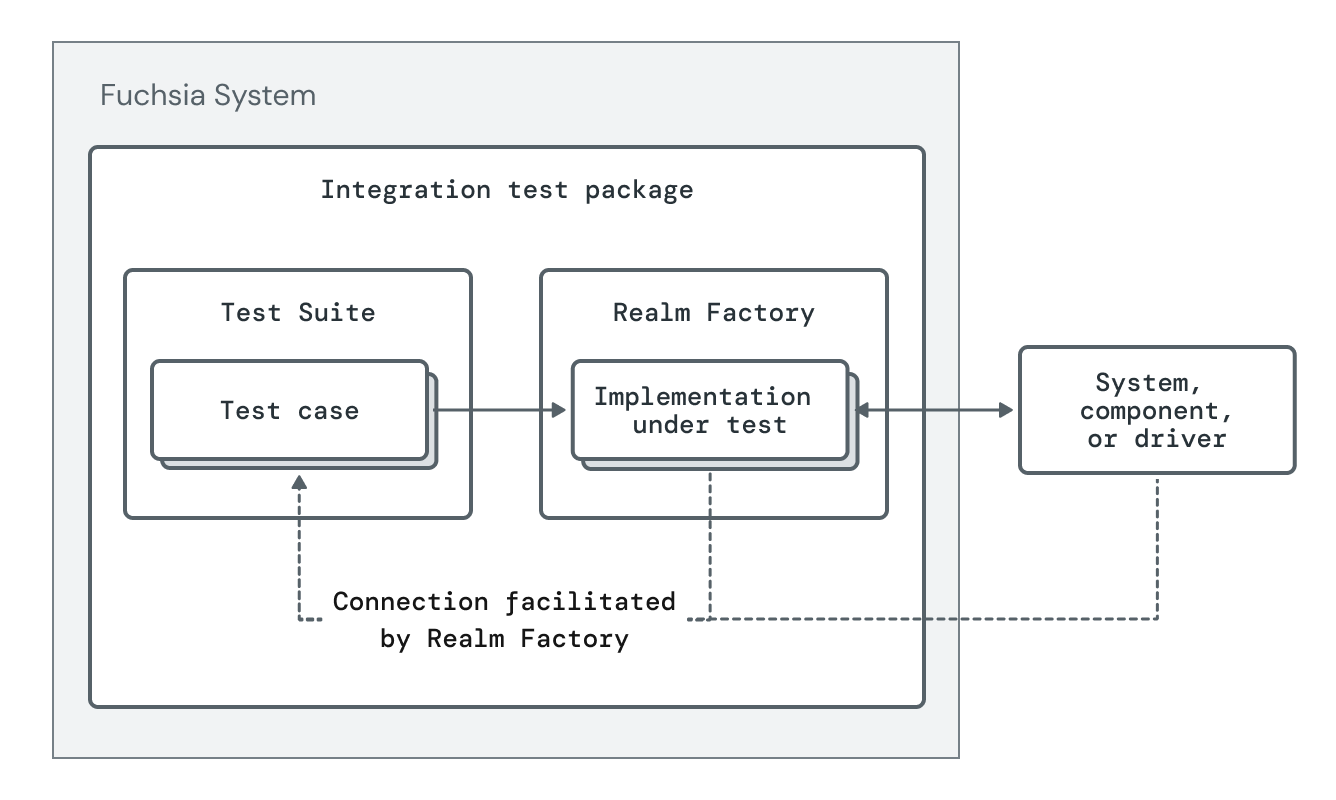
Tests that access system capabilities are called Non-hermetic Integration Tests. While they are technically not hermetic, they should still try to be as isolated as possible:
- Depend on only the necessary capabilities to run the test.
- Follow the Test Realm Factory style, albeit with dependent capabilities from the system rather than isolated.
- Prefer to depend on capabilities that make a best-effort to provide isolation between clients (e.g. separate contexts or sessions).
- Clean up state when the test is done.
Non-hermetic integration tests must be run in a location of the component topology that already has the required capabilities routed to it. A list of existing locations and instructions for adding new ones are here.
Non-hermetic Integration Tests should be used sparingly and for situations where no hermetic solution is practical. It is preferred that they are used as a stop-gap solution for a test that otherwise would be made hermetic given appropriate mocks or isolation features. They should not be used for tests that legitimately want to assert on the behavior of a given system globally (see instead On-device System Validation and Host-driven System Interaction Tests).
Compatibility Tests (CTF)
- What needs it: Protocols exposed in the SDK, but is also applicable to client libraries and tools.
- What does it test for: Platform ABI/API behavior consistency and compatibility
- What are its key benefits: Ensures that the behavior of platform protocols does not unexpectedly change in incompatible ways. Especially important for platform stability.
- Where to view coverage: CTF coverage dashboard.
- How to implement: Write a Test Realm Factory (TRF) integration test, enable CTF mode.
- Who writes this kind of test: All owners of SDK protocol implementations
- Where are the sources stored: fuchsia.git
- When does Fuchsia run this type of test: Commit-Queue and Continuous Integration
Compatibility tests provide early warning that a downstream breakage is possible due to a platform change, and it is especially important to ensure that our platform ABI remains stable. In general, every FIDL protocol's stable API exposed by the SDK should have a compatibility test for its API levels.
These tests verify that clients of the protocols, targeting a stable API level and built with the SDK, will receive a platform that is compatible with their expectations.
FIDL protocols evolve over time both in terms of their stated interface as well as the behaviors they exhibit. A common error arises when the output of some protocol changes in a way that differs from previous expectations.
These errors are difficult to identify using only integration tests, since the tests are often updated at the same time as the implementation they are testing. Furthermore, we need to maintain a degree of compatibility across the API revisions exposed in the SDK.
Compatibility Tests for Fuchsia (CTF) enable different versions of a component implementation to be tested against different sets of test expectations for compatibility. The TRF pattern is fully integrated with CTF, and TRF tests may be nominated for compatibility testing via a config change (no source change necessary).
The mechanism is as follows:
- For each milestone release (F#) of Fuchsia, retain the Test Suite as it existed at that milestone.
- For each platform change, run each retained Test Suite against the RealmFactory for each milestone release.
The end result is that the old expectations for behavior of exposed protocols are maintained across future modifications. Failing to provide this coverage means that subtle changes to the behavior or interface of SDK protocols will cause downstream breakages that are especially difficult to root cause.
The diagram below shows compatibility tests for using the Test Realm Factory (TRF) pattern and a frozen component fake.
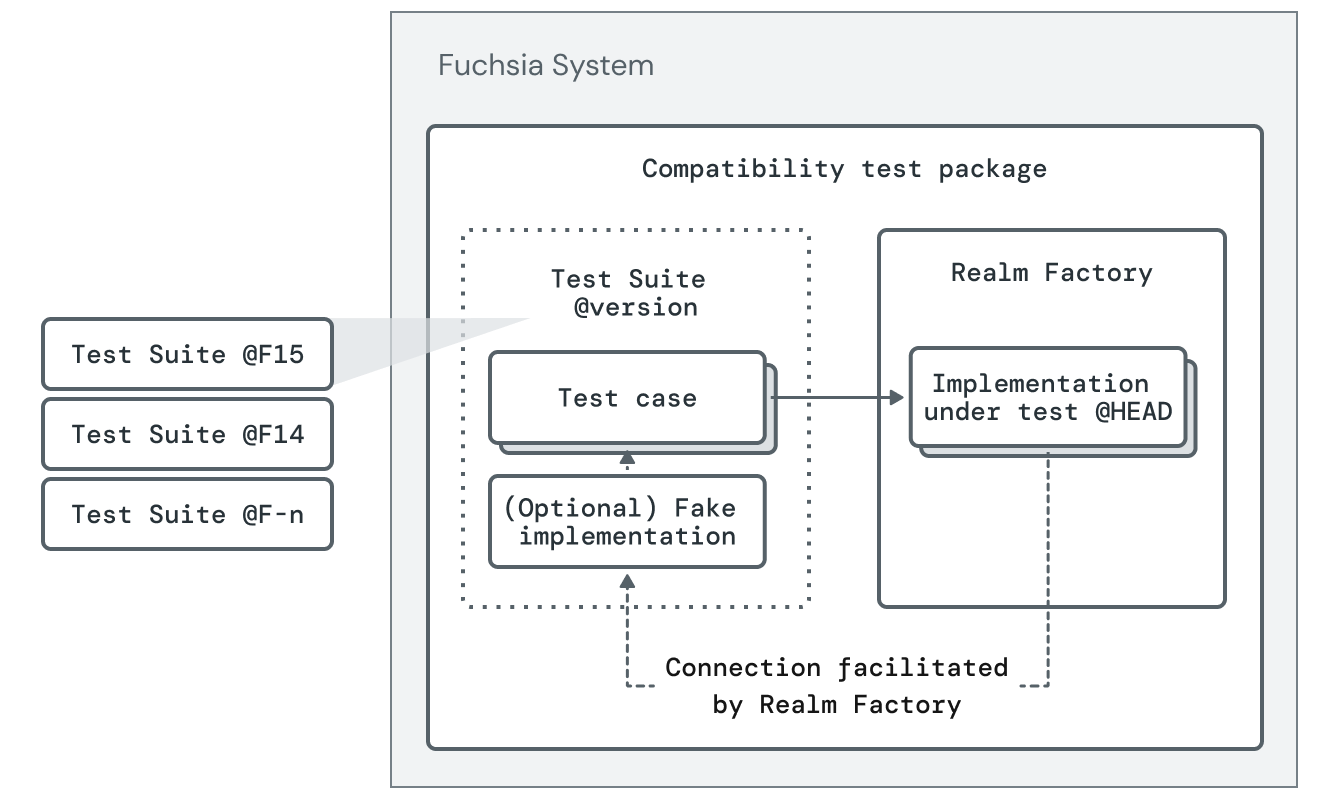
Enabling CTF mode for a TRF test is a simple configuration option, and converting existing integration tests to TRF is straightforward (examples). Authors of components/drivers that implement SDK protocols should prioritize converting their tests to TRF and enable CTF mode to help stabilize the Fuchsia platform and save themselves ongoing large scale change overhead.
All components exposing protocols in the partner or public SDK should have a CTF test.
Spec Conformance Tests
- What needs it: Out-of-tree (OOT) drivers, components undergoing migration from one implementation to another, (some) framework clients.
- What does it test for: Consistency between different implementations of a protocol or library, to ensute they conform to the spec.
- What are its key benefits: Ensures that different implementations of the same interface exhibit compatible behavior. This is especially useful for drivers where there may be multiple implementers of the same interface.
- Where to view coverage: TODO
- How to implement: Use parts of an existing TRF integration test to create a new TRF test. Alternatively write this test in Lacewing to interact with a complete system.
- Who writes this kind of test: Contract/protocol owners define a test for requirements, and downstream users reuse or compose pieces of that test to ensure their code meets the requirements.
- Where are the sources stored: fuchsia.git or built via the SDK in stand-alone repos
- When does Fuchsia run this type of test: Commit-Queue, out-of-tree continuous integration.
It is common for the Fuchsia Platform to define a contract that must be fulfilled by one or more implementations, some of which may be defined outside of the fuchsia.git repository:
- The Fuchsia SDK defines driver APIs which must be implemented by drivers outside of the Fuchsia source tree (out-of-tree). The drivers must produce results that are consistent with the expectations the platform has for them.
- Component rewrites consist of one existing and one in-progress code base, which must remain consistent. For example, if we were rewriting the filesystem storage stack, we want to make sure writing and reading files produces results consistent with the original implementation.
- Client libraries like Inspect and logs are implemented in multiple
languages, and the implementation includes writing a binary format.
It is important that the action
LOG("Hello, world")produces binary-compatible output no matter the library producing it.
It is important to know that an implementation conforms to the specification, and a Spec Conformance Test is used to validate this is the case.
Hermetic approach to spec conformance tests
We test driver conformance by exercising the driver and checking for expected behaviour - for drivers that control devices this will require running on hardware (recommended approach). This is run by driver developers using the SDK at their desk (on hardware), and in their CI/CQ
Spec Conformance Tests may build on top of TRF tests to have identical structure to Compatibility Tests. In this scenario, the primary difference is in how the different pieces of the TRF test are used.
The recommended pattern for Spec Conformance testing is to define a RealmFactory (containing an implementation under test), a Test Suite (validating the implementation of the specification) wherever the contract is defined (e.g. fuchsia.git for SDK protocols), and the FIDL protocol for driving the test (which is responsible for instantiating and interacting with a set of components under test). The Test Suite and FIDL protocol are distributed to implementers (for example, through the SDK). Developers who implement the contract may use the distributed Test Suite and implement their own RealmFactory that wraps their implementation behind the FIDL protocol. This means that the same exact set of tests that define the contract are applied to each implementation.
The diagram below shows an approach for running spec conformance tests in a hermetic way.
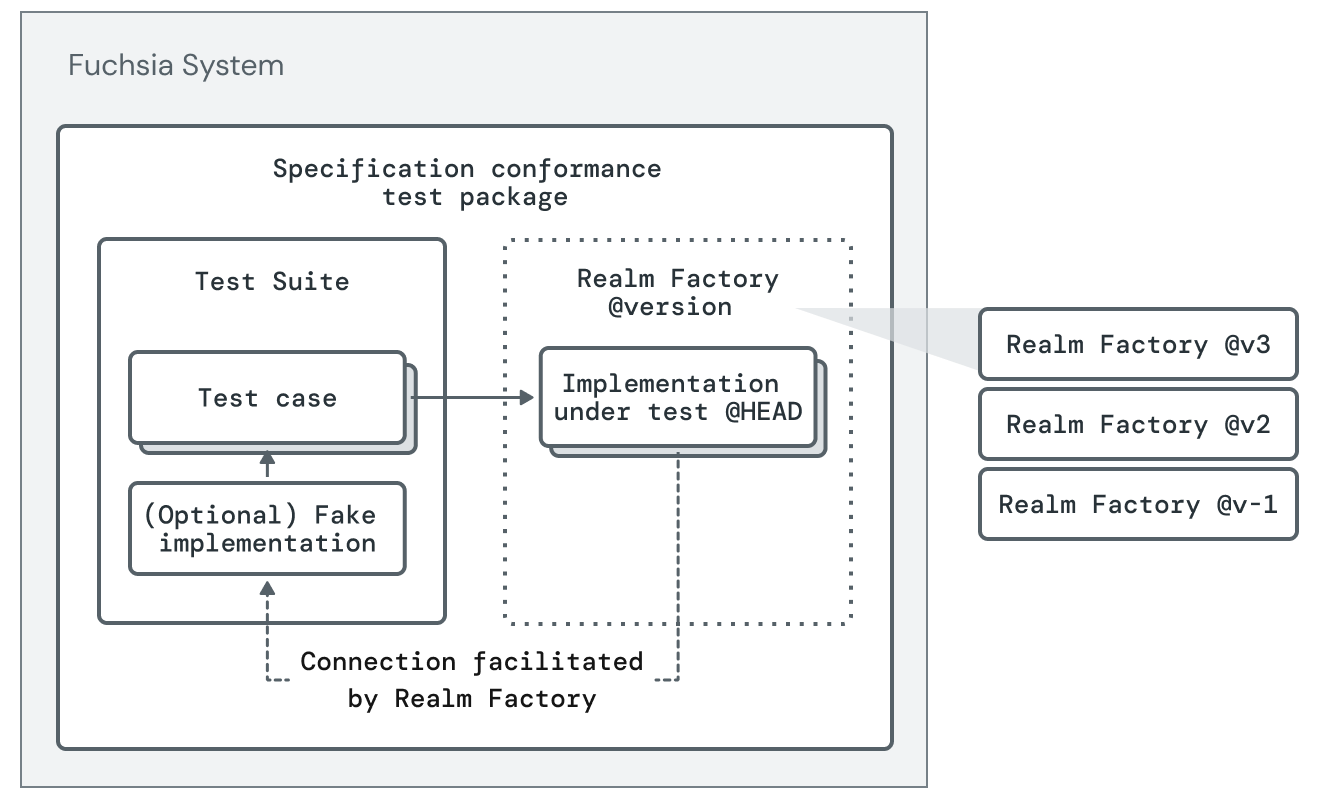
Non-hermetic approach to spec conformance tests
The non-hermetic approach to test spec conformance is to run the test on a working system using Lacewing for (hardware-dependent implementation). This is run by developers in their CI/CQ against the product implementation.
The diagram below shows an approach for running spec conformance tests in a non-hermetic way.
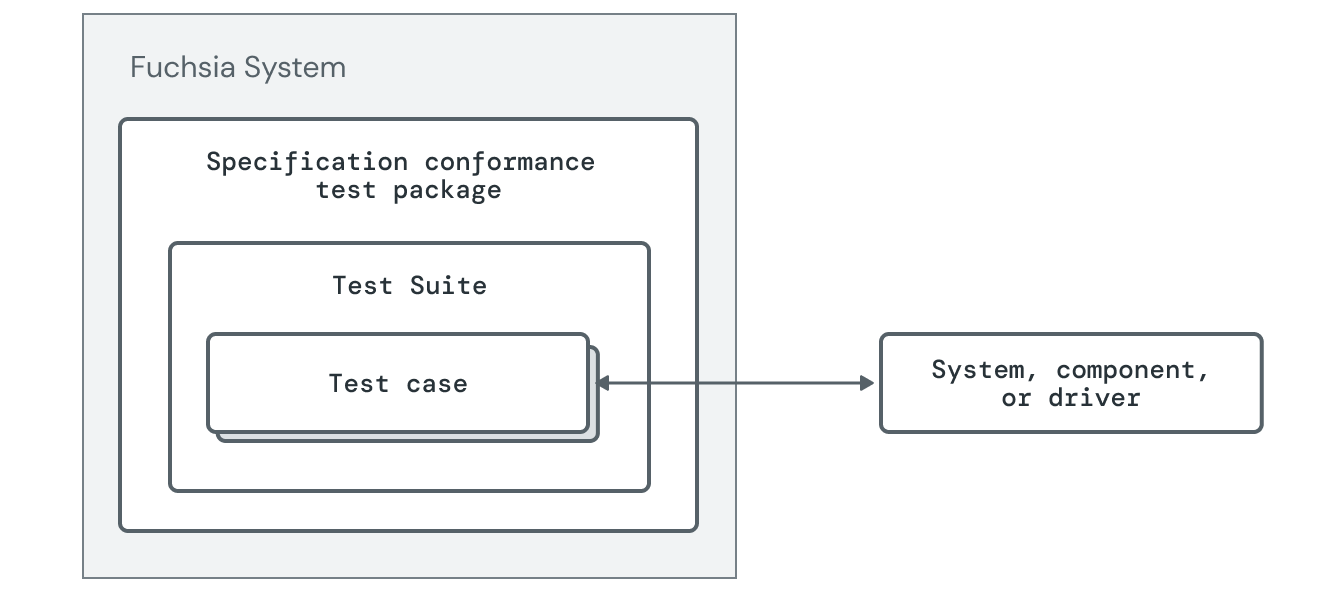
Host-driven approach to spec conformance tests
Alternatively, Spec Conformance tests may be written using Lacewing and run as host-driven system interaction tests. This is particularly useful when the implementer of the protocol is a driver or otherwise depends on specific hardware. This is especially useful to assert that product images including the driver both conform to the spec and were appropriately assembled to support interacting with hardware.
The diagram below shows an approach for running spec conformance tests in a host-driven way.
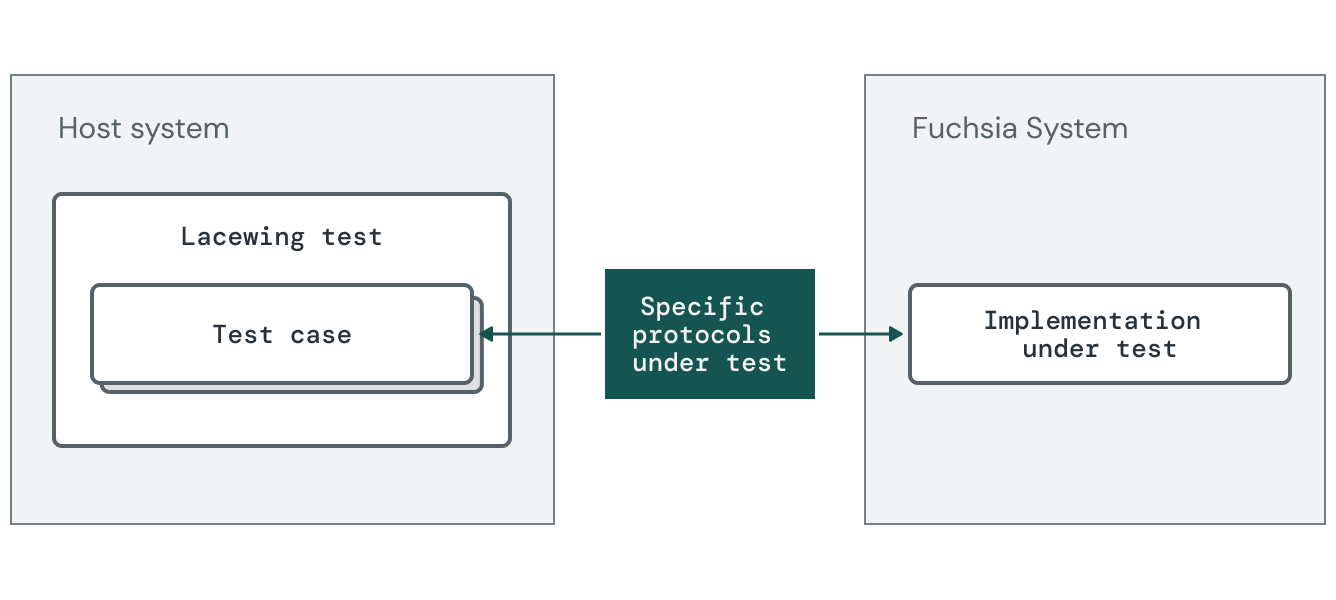
More concretely, we can solve the above examples as follows:
- Drivers: Define driver FIDL in fuchsia.git. Create a TRF test with associated Test Suite and FIDL protocol; ship them in the SDK. In an out-of-tree driver repo, implement the driver, create a RealmFactory that wraps the driver and implements the test FIDL. Run the distributed Test Suite against that RealmFactory.
- Drivers (Lacewing): Create a Lacewing test that interacts with the driver's FIDL protocols from the host. Ship this test as a binary artifact that can be run in out-of-tree driver repos or during product assembly.
- Component rewrite: Create a new code base for the rewrite, create a skeleton TRF test implementing the test FIDL (following best practices to return non-failing UNSUPPORTED values), with the Test Suite from the existing implementation. Incrementally rewrite the component, and as test cases begin pass set failures for those cases to blocking. When all test cases pass, the rewrite is done, delete the old implementation.
- Client libraries in multiple languages: Define the operations that are possible in your library as a test FIDL. Create a TRF test for one implementation of the library, then use the Test Suite from that implementation for all other implementations. They will remain conformant.
Interfaces that are expected to be implemented multiple times should ship a spec conformance test for integrators to build on top of.
Platform Expectation Tests
- What needs it: Many platform components and drivers. For example, drivers should ensure they interact with actual hardware on an assembled system.
- What does it test for: Behavior of the component/driver on an assembled product image
- What are its key benefits: Ensures that a platform component/driver behaves as expected when installed in an actual product. Helps to catch issues with capability routing and interactions with real hardware.
- Where to view coverage: TODO
- How to implement: Write a Test Realm Factory (TRF) integration test, create an execution realm, enable system validation mode (TODO). Take tests that assert on specifications and run these at every stage of the pipeline (reuse is highly encouraged). Leverage Platform Expectations Test Suit (PETS).
- Who writes this kind of test: Owners of platform components and drivers
- Where are the sources stored: fuchsia.git, shipped in the SDK to out-of-tree repositories
- When does Fuchsia run this type of test: Commit-Queue, out-of-tree continuous integration.
The diagram below shows platform expectation tests where the tests are shipped with the SDK.

Hermetic integration tests ensure that a component performs correctly in isolation, but it does not validate that an assembled system image including that component works properly. System validation tests are a special kind of non-hermetic integration test that ensures the real component behaves as expected, subject to some constraints.
Platform Expectation tests are typically based on hermetic TRF tests consisting of a RealmFactory and Test Suite. Instead of using the RealmFactory (which instantiates isolated components under test), system validation tests use a stand-in component that provides access to the real system capabilities.
For example, if you are testing fuchsia.example.Echo, your hermetic
TRF test will provide a RealmFactory that exposes
fuchsia.example.test.EchoHarness over which you can CreateRealm()
to obtain an isolated fuchsia.example.Echo connection. A system
validation test's stand-in component also implements CreateRealm(),
but provides a real fuchsia.example.Echo connection from the
system itself.
This pattern allows you to use the exact same test code in hermetic
and non-hermetic cases, with incompatibilities handled by the
UNSUPPORTED return value.
To illustrate how this would work, consider system validation testing
with a harness that includes method SetUpDependency() in addition
to CreateRealm(). If it is not possible to set up the dependency
when running in a non-hermetic setting, that method simply returns
UNSUPPORTED and tests that depend on it are skipped. Consider
having test cases read_any_data() and read_specific_data() which
skip calling SetUpDependency() and do call it respectively. The
former case ensures that any data can be read in the correct format
(both hermetically and non-hermetically), while the latter case
ensures that specific data is returned (hermetically only).
To aid OOT system integrators, we may ship system validation test suites in the SDK to be run against assembled product images OOT. This is a primary mechanism for validating the behavior of drivers written OOT.
Platform components and drivers should have system validation tests. The Fuchsia SDK should make a validation test suite available for each driver expected to be implemented in a separate repository.
System Interaction (Product) Tests
- What needs it: Some components and drivers; individual user journeys (for instance, validating responses when the user touches the screen).
- What does it test for: Behavioral regressions in system services and individual user journeys.
- What are its key benefits: Has complete control over one or more Fuchsia devices and non-Fuchsia peripherals. Covers cases requiring multiple devices, rebooting devices, or simulating user interaction with a device.
- Where to view coverage: TODO
- How to implement: Write a Python test using Mobly/Lacewing
- Who writes this kind of test: Component/driver owners; product owners
- Where are the sources stored: fuchsia.git or OOT
- When does Fuchsia run this type of test: Commit-Queue, OOT Continuous Integration as needed
Fuchsia makes hermetic testing possible for a wide range of cases that would be infeasible to write on other systems, but in some cases there is just no replacement for physically controlling an entire device. Instead of running these tests on the device under test, the host system instead takes responsibility for controlling one or more devices to exercise end-to-end code paths.
A host-driven system interaction test has the ability to fully control a Fuchsia device using SDK tools and direct connection to services on the device. They are written using the Lacewing framework (build on Mobly).
Tests that use Lacewing can arbitrarily connect to services on a target system. Some tests are written to target specific drivers or subsystems (e.g. does the real-time clock save time across reboots?), some are written to cover user journeys that require device-wide configuration (e.g. can a logged-in user open a web browser and navigate to a web page?), and some are written to control a number of Fuchsia and non-Fuchsia devices in concert (e.g. can a Fuchsia device pair with a bluetooth accessory?).
With the Lacewing Framework, interactions with the device are handled through "affordances," which provide evolvable interfaces to interact with specific device subsystems (e.g. Bluetooth affordance, WLAN affordance, etc).
Diagram shows an approach for running system interaction tests using Lacewing.
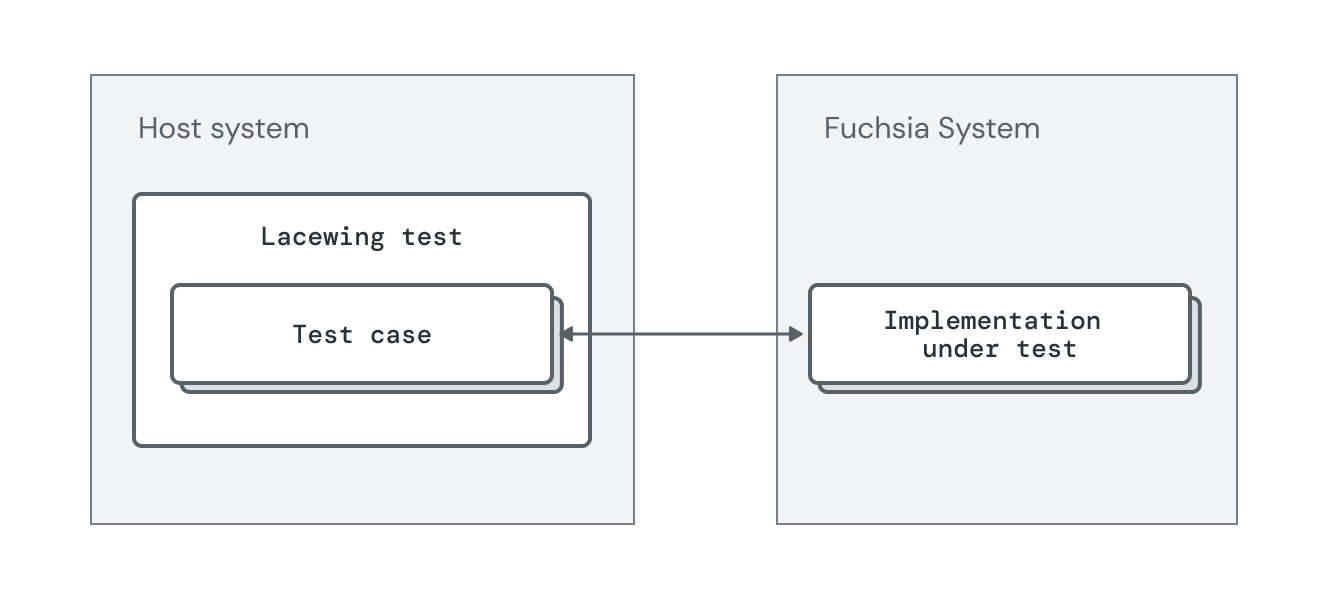
As with most end-to-end (E2E) tests, this kind of testing can be expensive for several reasons:
- Tests often need to run on specific real hardware setups.
- E2E tests are less performant, which increases CI/CQ latency and load.
- E2E tests are not isolated, which can increase their flakiness if state is not managed appropriately.
E2E testing should be done sparingly for those reasons, but often it is the last line of defense that covers one of the hardest testing gaps: ensuring that a real user interacting with a system will see the desired outputs.
Some system components and drivers need this kind of test, but the main benefit of using Lacewing is to cover real-world device interactions that cannot be covered by isolated on-device tests. Choosing between system validation and Lacewing is often a judgement call, but there is space for both kinds of testing in a complete test strategy. Test authors should seek to get the coverage they need for the lowest maintenance cost.
